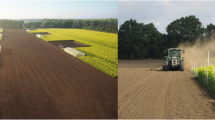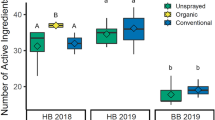Abstract
Agricultural seed-coat treatments are prone to drift as seed coatings may scuff off and become incorporated into field particles during planting. Vacuum planters release exhaust and kick up field dust, laden with systemic pesticides that blow across the landscape, is taken up, and later expressed in the nectar and pollen of surrounding plants. Offsite movements and nontarget exposure to systemic pesticides need attention and determining how and at what exposure levels pollinators are exposed is of critical importance. Unfortunately, this requires extensive and costly instrumental analyses. Here, we describe dust sampling and a modified, rapid method based on liquid chromatography in tandem with mass spectrometry—based method for quantification of a broad array of agrochemicals in captured dust particles. This method increases ability to detect potential exposure to multiple agrochemicals and allows researchers to better address critical knowledge gaps in the environmental fate, off-target movement, and persistence of conventional seed treatments.
Similar content being viewed by others
References
Batista AC, da Domingues CE, Costa C, Silva-Zacarin MJ ECM (2020) Is a strobilurin fungicide capable of inducing histopathological effects on the midgut and Malpighian tubules of honey bees? J Apic Res 59(5):834–843. https://doi.org/10.1080/00218839.2020.1724678
Blacquière T, Smagghe G, van Gestel CAM, Mommaerts V (2012) Neonicotinoids in bees: a review on concentrations, side-effects and risk assessment. Ecotoxicology 21:973–992. https://doi.org/10.1007/s10646-012-0863-x
Bonmatin JM, Moineau I, Charvet R et al (2003) A LC/APCI-MS/MS method for analysis of imidacloprid in soils, in plants, and in pollens. Anal Chem 75:2027–2033. https://doi.org/10.1021/ac020600b
Bonmatin JM, Giorio C, Girolami V et al (2015) Environmental fate and exposure; neonicotinoids and fipronil. Environ Sci Pollut Res 22:35–67. https://doi.org/10.1007/s11356-014-3332-7
Botías C, David A, Horwood J et al (2015) Neonicotinoid residues in wildflowers, a potential route of chronic exposure for bees. Environ Sci Technol 49:12731–12740. https://doi.org/10.1021/acs.est.5b03459
Campbell JB, Nath R, Gadau J et al (2016) The fungicide Pristine® inhibits mitochondrial function in vitro but not flight metabolic rates in honey bees. J Insect Physiol 86:11–16. https://doi.org/10.1016/j.jinsphys.2015.12.003
European Food Safety Authority (2010) Conclusion on the peer review of the pesticide risk assessment of the active substance azoxystrobin. EFSA J 8(4):15421542. doi:https://doi.org/10.2903/j.efsa.2010.1542
Feng Y, Huang Y, Zhan H, Bhatt P, Chen S (2020) An overview of strobilurin fungicide degradation: current status and future perspective. Front Microbiol 11:389. https://doi.org/10.3389/fmicb.2020.00389
Forero LG, Limay-Rios V, Xue Y, Schaafsma A (2017) Concentration and movement of neonicotinoids as particulate matter downwind during agricultural practices using air samplers in southwestern Ontario, Canada. Chemosphere 188:130–138. https://doi.org/10.1016/j.chemosphere.2017.08.126
Friessleben R, Schad T, Schmuck R, Schnier H, Schöning R, Nikolakis A (2010) An effective risk management approach to prevent bee damage due to the emission of abraded seed treatment particles during sowing of neonicotinoid treated maize seeds. Aspects Appl Biol 99:277–282
Giffard H, Dupont T (2009) A methodology to assess the impact on bees of dust from coated seeds. Julius-Kühn‐Arch 423:73–75
Gill RJ, Ramos-Rodriguez O, Raine NE (2012) Combined pesticide exposure severely affects individual- and colony-level traits in bees. Nature 491:105–108. https://doi.org/10.1038/nature11585
Goulson D (2013) An overview of the environmental risks posed by neonicotinoid insecticides. J Appl Ecol 50:977–987. doi: https://doi.org/10.1111/1365-2664.12111
Greatti M, Barbattini R, Stravisi A et al (2006) Presence of the a.i. imidacloprid on vegetation near corn fields sown with Gaucho® dressed seeds. Bull Insectology 59:99–103
Harrington P, Mathers JJ, Smith Sand Glass CR (2004) Methods for the evaluation of granular drift. Aspects Appl Biol 71:197–200
Herbst A, Rautmann D, Osteroth HJ, Wehmann HJ, Ganzelmeier H (2010) Drift of seed dressing chemicals during the sowing of maize. Aspects Appl Biol 99:265–269
Khandelwal A, Gupta S, Gajbhiye VT, Varghese E (2014) Degradation of kresoxim-methyl in soil: impact of varying moisture, organic matter, soil sterilization, soil type, light and atmospheric CO2 level. Chemosphere 111:209–217. https://doi.org/10.1016/j.chemosphere.2014.03.044
Krupke CH, Holland JD, Long EY, Eitzer BD (2017a) Planting of neonicotinoid-treated maize poses risks for honey bees and other non-target organisms over a wide area without consistent crop yield benefit. J Appl Ecol 54:1449–1458. https://doi.org/10.1111/1365-2664.12924
Krupke CH, Alford AM, Cullen EM, Hodgson EW et al (2017b) Assessing the value and pest management window provided by neonicotinoid seed treatments for management of soybean aphid (Aphis glycines Matsumura) in the Upper Midwestern United States. Pest Manag Sci 73(10):2184–2193. https://doi.org/10.1002/ps.4602
Main AR, Headley JV, Peru KM et al (2014) Widespread use and frequent detection of neonicotinoid insecticides in wetlands of Canada’s Prairie Pothole Region. PLoS ONE 9:e92821. https://doi.org/10.1371/journal.pone.0092821
Marzaro M, Vivan L, Targa A et al (2011) Lethal aerial powdering of honey bees with neonicotinoids from fragments of maize seed coat. Bull Insectology 64(1):119–126
Nikolakis A, Chapple A, Friessleben R, Neumann P, Schad T, Schmuck R, Schnier H-F, Schnorbach H-J, Schöning R, Maus C (2009) An effective risk management approach to prevent bee damage due to the emission of abraded seed treatment particles during sowing of seeds treated with bee toxic insecticides pp. 132–148. In Proceedings, Hazards of pesticides to bees-10th International Symposium of the ICP-Bee Protection Group. Julius-Kühn-Archives 423:132–148
Pisa L, Goulson D, Yang E-C et al (2017) An update of the Worldwide Integrated Assessment (WIA) on systemic insecticides. Part 2: impacts on organisms and ecosystems. Environ Sci Pollut Res 28:11749–11797. https://doi.org/10.1007/s11356-017-0341-3
Rundlöf M, Andersson GKS, Bommarco R et al (2015) Seed coating with a neonicotinoid insecticide negatively affects wild bees. Nature 521:77–80. https://doi.org/10.1038/nature14420
Sánchez-Bayo F, Goka K, Hayasaka D (2016) Contamination of the aquatic environment with neonicotinoids and its implication for ecosystems. Front Environ Sci 4:71. https://doi.org/10.3389/fenvs.2016.00071
Sandrock C, Tanadini LG, Pettis JS et al (2014) Sublethal neonicotinoid insecticide exposure reduces solitary bee reproductive success. Agric For Entomol 16:119–128. https://doi.org/10.1111/afe.12041
Sur R, Stork A (2003) Uptake, translocation and metabolism of imidacloprid in plants. Bull Insectology 56:35–40
Stewart SD, Lorenz GM, Catchot AL, Gore J et al (2014) Potential exposure of pollinators to neonicotinoid insecticides from the use of insecticide seed treatments in the mid-southern United States. Environ Sci Tech 48:9762–9769. https://doi.org/10.1021/es501657w
Tapparo A, Marton D, Giorio C et al (2012) Assessment of the environmental exposure of honeybees to particulate matter containing neonicotinoid insecticides coming from corn coated seeds. Environ Sci Technol 46:2592–2599. https://doi.org/10.1021/es2035152
USEPA (1986) Guidelines for establishing test procedures for the analysis of pollutants – Definition and Procedure for the Determination of the Method Detection Limit – Revision 1.11. Electronic Code of Federal Regulations Title 40: Protection of Environment (Part 136), Appendix B to Part 136 – Definition and Procedure for the Determination of the Method Detection Limit – Revision 131.111
USEPA (2016) Definition and procedure for the determination of the Method Detection Limit, revision 2 https://www.epa.gov/sites/production/files/2016-12/documents/mdl-procedure_rev2_12-13-2016.pdf. Assessed 26 July 2020
Whitehorn PR, O’Connor S, Wackers FL, Goulson D (2012) Neonicotinoid pesticide reduces bumble bee colony growth and queen production. Science. https://doi.org/10.1126/science.1215025
Wood TJ, Goulson D (2017) The environmental risks of neonicotinoid pesticides: a review of the evidence post 2013. Environ Sci Pollut Res Int 24:17285–17325. https://doi.org/10.1007/s11356-017-9240-x
Woodcock BA, Bullock JM, Shore RF et al (2017) Country-specific effects of neonicotinoid pesticides on honey bees and wild bees. Science 356:1393–1395. https://doi.org/10.1126/science.aaa1190
Wu-Smart J, Spivak M (2016) Sub-lethal effects of dietary neonicotinoid insecticide exposure on honey bee queen fecundity and colony development. Sci Rep 6:1–11. https://doi.org/10.1038/srep32108
Xue Y, Limay-Rios V, Smith J, Baute T, Forero LG, Schaafsma A (2015) Quantifying neonicotinoid insecticide residues escaping during maize planting with vacuum planters. Environ Sci Technol 49:13003–13011. https://doi.org/10.1021/acs.est.5b03753
Acknowledgements
The authors are grateful to all the staff at the Water Science Laboratory for their assistance in analytical methods development, as well as sample and data analysis. The authors have no relevant financial or non-financial interests to disclose. The authors have no competing interests to declare that are relevant to the content of this article. All authors certify that they have no affiliations with or involvement in any organization or entity with any financial interest or non-financial interest in the subject matter or materials discussed in this manuscript. The authors have no financial or proprietary interests in any material discussed in this article. This paper is based on research that is supported by the Nebraska Agricultural Experiment Station with funding from the Hatch Multistate Research capacity funding program (Accession Number 1011128) from the USDA National Institute of Food and Agriculture and the USDA National Agroforestry Center and Core facility grant #1 C-14106.
Author information
Authors and Affiliations
Corresponding author
Additional information
Publisher’s Note
Springer Nature remains neutral with regard to jurisdictional claims in published maps and institutional affiliations.
Supplementary Information
Below is the link to the electronic supplementary material.
Rights and permissions
Springer Nature or its licensor (e.g. a society or other partner) holds exclusive rights to this article under a publishing agreement with the author(s) or other rightsholder(s); author self-archiving of the accepted manuscript version of this article is solely governed by the terms of such publishing agreement and applicable law.
About this article
Cite this article
Gupta Vakil, S., Biswas, S., Snow, D. et al. Targeted Method for Quantifying Air-Borne Pesticide Residues from Conventional Seed Coat Treatments to Better Assess Exposure Risk During Maize Planting. Bull Environ Contam Toxicol 109, 1051–1058 (2022). https://doi.org/10.1007/s00128-022-03627-y
Received:
Accepted:
Published:
Issue Date:
DOI: https://doi.org/10.1007/s00128-022-03627-y




